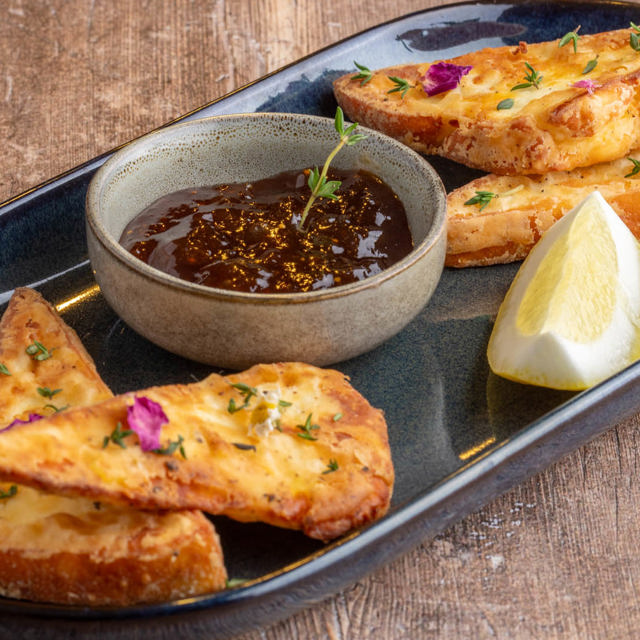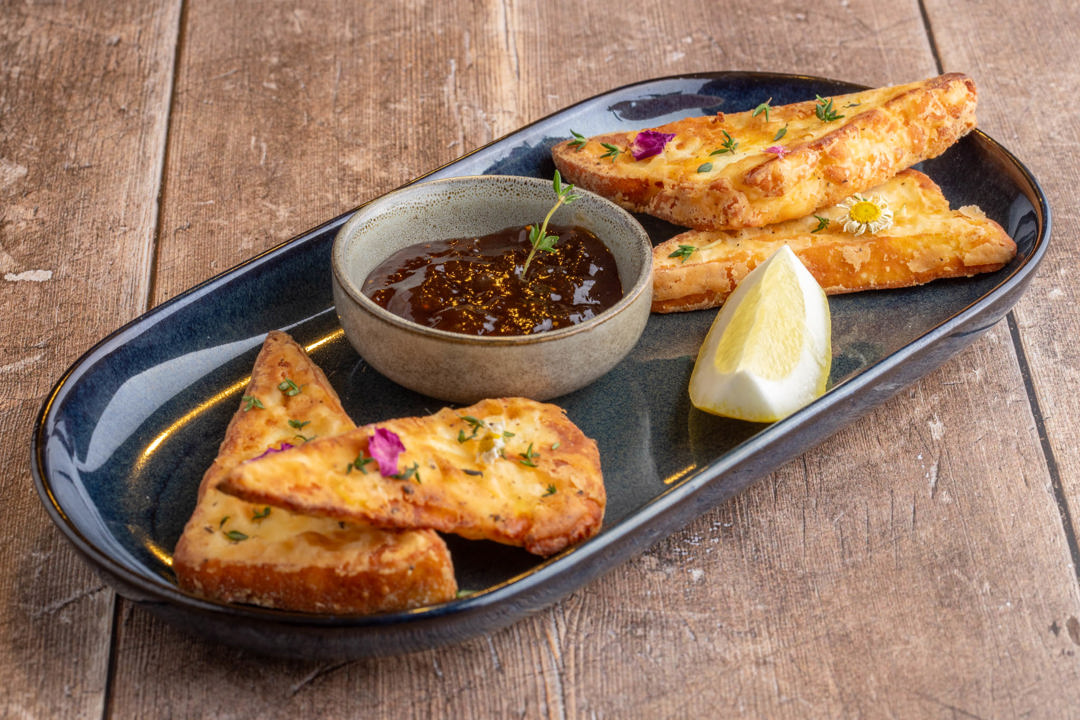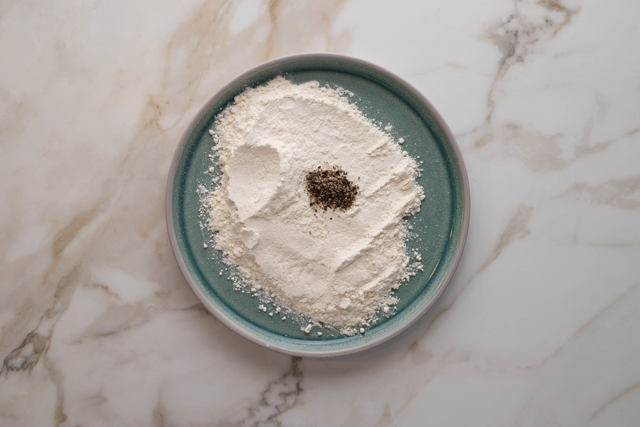Aside from souvlaki and Greek salad, saganaki cheese was the first Greek food I remember eating. It’s Greek food at its finest - simple, punchy flavours that complement each other well. Given how often you see it come out of the kitchen in Greek tavernas and restaurants, it’s certainly a very popular dish and a true Greek taverna favourite!
This dish is often just called "saganaki". Saganaki is a Greek word that describes a specific type of dual handled frying pan and the method of cooking - you can get other saganaki dishes, such as prawn saganaki . Saganaki cheese is usually served as an appetizer or as part of a larger meze spread.
What is Saganaki cheese?
Saganaki Cheese is made with a firm Greek cheese, which is lightly floured and then shallow fried and served with something both sweet and sour - typically honey and lemon.
Saganaki cheese ingredients
The basics
- Cheese is the hero of this dish. Use a quality Greek PDO - my suggestions are kefalograviera, kefalotyri or graviera. You can use halloumi if you can’t get one of these cheeses, but halloumi won’t melt.
- Flour - coat the cheese with regular plain/all purpose flour. This fries up In the oil and provides the cheeses crust.
- Black pepper is used to season the flour and offsets the saltiness of the cheese.
- Extra virgin olive oil is used to shallow fry the cheese.
- Lemon cuts the fat of the cheese and pairs very well on its own with the cheese, but pairs even better with a quality jam or honey to bring some sweetness to the sour lemon juice.
To finish
- Honey or jam brings sweetness to the dish so you end up with a savoury/sweet/sour profile - it might sound a little weird, but trust me it works oh so well. My preference is fig jam!
- Ouzo or some other spirit, like brandy. It's optional but it adds to the flavour and is used to flambé the cheese.
- Fresh thyme or dried oregano to bring nice herby notes to the cheese.
How to make Saganaki Cheese
Cut the cheese - the cheese can’t be too thick or it will be too difficult to cook without burning the flour. It should be no more than 1cm (1/2 inch) thick. I like to cut it into triangular shapes, but you do you.
Flour - Prepare the flour by adding pepper (i) and mixing well to combine (ii). Roll the cheese in flour - the cheese should be wet enough for the flour to stick, but run under the tap to moisten if required. Shake off any excess and place on a plate, ready for frying.
Fry - over a medium high heat, shallow fry the cheese (i) until you start to see it melt and then flip to cook the other side. Remove and place on a plate with paper towel (ii).
Flambé - optional step, but it makes for quite the theatre during a dinner party. See instructions later in the post.
Finish with thyme or oregano, honey or jam and lemon juice.
Tips
- Choose quality Greek PDO cheeses for the best result.
- Keep your cheese slices no thicker than about 1cm (1/2") for the best results.
- If the flour won't stick to the cheese, dip the cheese in a bowl of water or wet it with tap water.
- For the perfect finish, serve while the cheese is hot and gooey.
What type of cheese can I use?
Hard Greek cheeses graviera, kefalotyri or kefalograviera are typically used when making saganaki. My preferred cheese for saganaki is kefalograviera but I find it very difficult to find locally and for the pictures in this recipe I used kefalotyri. You can also use halloumi which is more widely available, but halloumi won’t melt in the way the other cheeses will.
Use PDO cheeses wherever you can!
The flour won’t stick to my cheese! What do I do?
The flour on the cheese is an important part of the cooking process and gives you the characteristic crust for the cheese. If you can’t get the flour to stick, roll your cheese in water, shake the excess off then quickly roll in flour.
Flambéing saganaki cheese
If you want to flambé the saganaki cheese, you can do it with ouzo, brandy or any other high alcohol content spirit. By flambéing the cheese, you bring another dimension of flavour, and it’s still kid friendly because the alcohol burns off.
Prepare - When the cheese is cooked, remove the pan from the heat. If there is excess oil left in the pan, drain it.
Add alcohol - keeping the pan away from your face and any open flame, carefully pour over a shot of your spirit of choice (I suggest ouzo).
Ignite - light the alcohol with your stove (if using gas), or a long lighter or match. Keep clear of your skin and anything which might catch fire.
Don’t flambé if you don’t understand the risks and be mindful of pets and children. The flames can reach surprisingly high.
How to reheat and store leftovers?
You can reheat saganaki cheese by microwaving it in the microwave, however given the texture it will suffer so it’s best eaten when fresh.
What to serve with saganaki cheese?
Serve saganaki cheese as part of a meze board with other nibbles like keftedes, warmed olives, dips and pita bread - showcasing the best of Mediterranean cuisine!
Saganaki cheese is the perfect way to start your Greek dinner party!
As for serving the saganaki cheese… I love mine with a squeeze of lemon juice and some fig jam. It’s also great with honey, or even just the lemon.

Greek Fried "Saganaki" Cheese
| Prep | Cook | Total |
|---|---|---|
| 5 mins | 10 mins | 15 mins |
- 200g firm Greek cheese such as kefalograviera, kefalotyri or graviera see note 1
- 1/4 cup plain flour
- Freshly cracked pepper
- Extra virgin olive oil see note 2
- 30ml (1 shot) ouzo or brandy, optional see note 3
- 1 lemon, cut into wedges
- Fresh thyme, optional or dried oregano
- Honey or jam, optional I prefer fig jam - see note 4
- Prepare cheese - you don’t want the cheese much thicker than about 1cm. Cut the cheese in half if it is too thick. You can then cut it into triangles if you’d like - saganaki cheese is often served in triangle wedges.
- Prepare flour - add the flour to a plate and season well with cracked pepper. Stir to combine.
- Flour the cheese - roll the cheese in the flour and shake off any excess. If your cheese is too dry for the flour to adhere, run it under the tap to moisten and then try again.
- Heat oil - add enough oil to cover the base of a small pan, and then heat it over a medium high heat.
- Cook cheese - when the oil is hot, add the cheese and cook. When the cheese starts to melt and is browned, carefully flip it. Cook the other side until it’s golden brown - be gentle with the cheese to prevent it from breaking apart.
- 6. Flambé - this is an optional step, if you want to flambé it make sure you understand the risks and keep the pan away from your body and anything which might catch fire. Drain excess oil from the pan or use paper towel to blot it up. Remove the pan from any heat source or open flame and carefully add the spirit to the pan. Ignite with a gas burner, long match or lighter.
- Serve the cheese with lemon wedges (squeeze them over before you eat!) and honey or jam - see note.
- Cheese - Use a firm PDO Greek cheese such as kefalograviera, kefalotyri or graviera. You can also use halloumi but note that halloumi doesn’t melt so the texture won’t be quite right.
- Oil - use extra virgin olive oil. It’s difficult to give a quantity because you are shallow frying. You only need enough in the bottom of the pan to transfer heat into the bottom of the cheese.
- Alcohol - flambéing is an optional step, only do it if you understand the risks and make sure to keep your body away from the pan and the pan away from things which can burn. Don’t add alcohol if you’re not going to flambé.
- Honey / jam - choose one or the other - or skip it all together. My preference is fig jam; the idea is to get a savoury/sweet/sour profile when combined with the cheese and lemon.
























